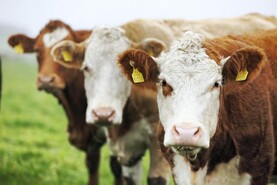Spring calving is just weeks from getting under way around the country. As January tends to be a quieter month on farms, with the cattle feeding being the main daily task, use any free time now to have sheds ready for the onset of calving.
Outlined are five tips to check that calving facilities are up to scratch for spring calving 2020.
1 Wash and disinfect pens
Calving pens should be washed and disinfected before they are required this spring. Power-wash walls and gates, removing all soiled matter.
Focus most on the areas where surgical procedures will occur. Spreading hydrated lime in calving pens will also help to cut down on disease in sheds.
Are all calving gates and dividing gates used in mothering pens in proper working order?
Replace gates if the headlock does not securely restrain cows that need assistance. Calving gates should also open forward to release a cow that goes down during labour. Fix all hinges, so that gates swing freely in both directions and can be securely locked in place.
Remember to think about safety when working with freshly calved cows. Cows can be quiet 51 weeks out of the year, but for a few days after calving, temperament can quickly change.
On the occasion that their calf has to be handled, it is essential that headlocking gates are in working order to allow you to safely enter the pen.
A cow can drink anywhere from 30l to 60l of water in the 24-hour period after calving. So if there is no water trough in the calving pen, now is the time to fit one.
Filling a bucket with water and leaving in a pen might seem like a good idea. But a bucket will only hold around 10l of water, so it needs to be constantly refilled.
However, more often than not, the cow will tip the bucket over and spill water, meaning there is a greater risk of cows becoming dehydrated after calving, which affects milk production.
Calving pens should have good lighting available for when cows calve during early morning, evening or night. Fitting LED lights will improve visibility, especially in pens where a cow will be sectioned.
5 Keep calving aids handy
Every herd will have a few cows that calve early, so locate all calving aids and store them in the calving shed from now on.
Fix a couple of shelves in the calving shed, or make use of empty clean storage containers to keep calving aids together, so that they are easily located when required.
Read more
In pictures: 2019 on Tullamore Farm
Healthy animals and happy farmers
Spring calving is just weeks from getting under way around the country. As January tends to be a quieter month on farms, with the cattle feeding being the main daily task, use any free time now to have sheds ready for the onset of calving.
Outlined are five tips to check that calving facilities are up to scratch for spring calving 2020.
1 Wash and disinfect pens
Calving pens should be washed and disinfected before they are required this spring. Power-wash walls and gates, removing all soiled matter.
Focus most on the areas where surgical procedures will occur. Spreading hydrated lime in calving pens will also help to cut down on disease in sheds.
Are all calving gates and dividing gates used in mothering pens in proper working order?
Replace gates if the headlock does not securely restrain cows that need assistance. Calving gates should also open forward to release a cow that goes down during labour. Fix all hinges, so that gates swing freely in both directions and can be securely locked in place.
Remember to think about safety when working with freshly calved cows. Cows can be quiet 51 weeks out of the year, but for a few days after calving, temperament can quickly change.
On the occasion that their calf has to be handled, it is essential that headlocking gates are in working order to allow you to safely enter the pen.
A cow can drink anywhere from 30l to 60l of water in the 24-hour period after calving. So if there is no water trough in the calving pen, now is the time to fit one.
Filling a bucket with water and leaving in a pen might seem like a good idea. But a bucket will only hold around 10l of water, so it needs to be constantly refilled.
However, more often than not, the cow will tip the bucket over and spill water, meaning there is a greater risk of cows becoming dehydrated after calving, which affects milk production.
Calving pens should have good lighting available for when cows calve during early morning, evening or night. Fitting LED lights will improve visibility, especially in pens where a cow will be sectioned.
5 Keep calving aids handy
Every herd will have a few cows that calve early, so locate all calving aids and store them in the calving shed from now on.
Fix a couple of shelves in the calving shed, or make use of empty clean storage containers to keep calving aids together, so that they are easily located when required.
Read more
In pictures: 2019 on Tullamore Farm
Healthy animals and happy farmers






 This is a subscriber-only article
This is a subscriber-only article










SHARING OPTIONS: